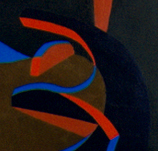|
 |
Centaur Painting 4
Acrylic Paint on Canvas, August 2000, 75cm x 60cm
Centaur Painting 4
This painting is one of the first attempts at representing the Centaur in both 2D jigsaw puzzle form and in a range of viewpoints of the 3D assembled Centaur form.
Only 7 colours are used in this painting and all are applied as a smooth colour with no tonal variations.
Despite this lack of tonal variation, the painting has a strong sense of the ‘3D’ that is achieved through shape and the hierarchy of colours receding and emerging from the flat surface of the canvas. This use of colour ranges from the black that recedes into the background, through to the red and the pink that come forward in relation to the other colours.
Perhaps, the most outstanding colour in the painting is the pink form. This stands out in several ways.
• The pink colour tends to come forward in relation to the other colours.
• It is the largest single mass of colour in the painting.
• The location of the pink shape is in a prominent position.
• The pink colour is used only once in the entire painting.
• The pink shape is perhaps the most recognisable shape within the painting – that of the human upper body of The Centaur form that suggests a ‘head’ and a pointing ‘arm’.
With this in mind, one might suspect that upon first glancing at this painting, the pink shape would ‘jump off the canvas’ and be the obvious place to being looking. This may be so, and yet this painting has no cohesive single place from which to look to get a ‘coherent’ view of the total image.
As such, this painting has more in common with a Cubist painting that has multiple viewpoints within a single picture than a Renaissance Perspective based representation. Instead of seeing a single view of the Centaur, a collision of shapes indicate the Centaur form in various multiple snapshots.
There are at least five different and major configurations represented in the single painting. The two obvious ones are at the bottom left and right of the painting hinting at the front horse legs of The Centaur and the rear horse legs. In the centre of the painting is the front horse legs shown upside down to the rest of the image and consistent with the key blue piece in its 2D plan form. At the top left is another configuration which is rendered as a flat 2D like image. On the top right hand side viewable at a 90° angle to the rest of the painting is the front junction of legs split in two forms.
This array of multiple views urges the viewer to look at a series of connected pieces making the overall image less easy to digest in a single take. In addition to this, not only are there separate views within the single picture frame, there are also multiple views possible of the same set of elements.
 For example, in the bottom right corner (see right), the red streak at the top suggests an underside of the ‘tail’ of the Centaur and yet its shape in relation to the navy blue suggests it may also be the top of the same section. Similarly, if one follows the line of the same red streak to its narrow end where it connects with the blue and the brown, there are several ways these forms may be read. For example, in the bottom right corner (see right), the red streak at the top suggests an underside of the ‘tail’ of the Centaur and yet its shape in relation to the navy blue suggests it may also be the top of the same section. Similarly, if one follows the line of the same red streak to its narrow end where it connects with the blue and the brown, there are several ways these forms may be read.
This idea of multiple levels of views within the same picture is similar to the notion of a fractal image that replicates itself at every decreasing magnifications and enlargements.
previous • next
|
 |
| |
|
|

|
|

